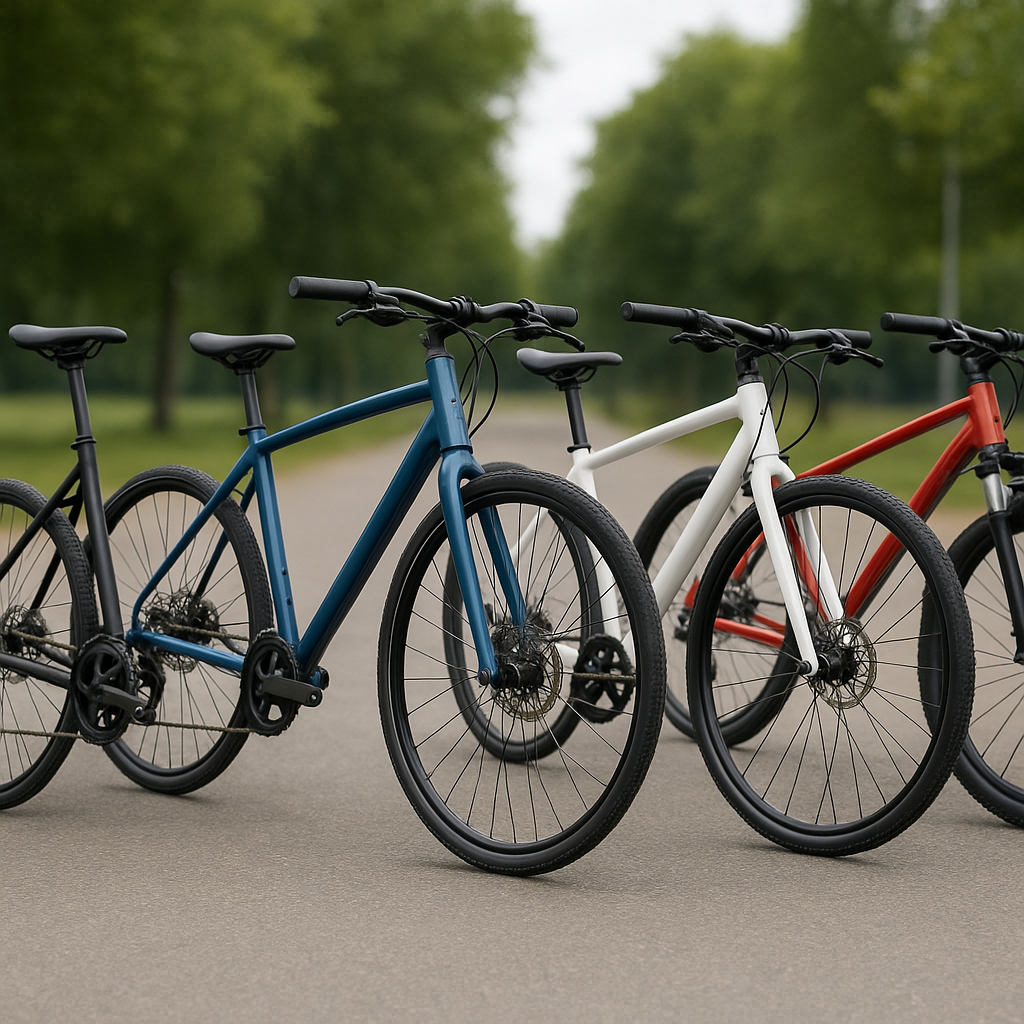Understanding the different frame materials for various bike types is crucial for any cycling enthusiast or potential bike buyer. The frame is the backbone of the bicycle, and its material significantly impacts the bike’s performance, weight, durability, and cost. This article delves into the most common frame materials used in bicycles, exploring their unique characteristics and suitability for different types of cycling.
Aluminum Frames
Aluminum is one of the most popular materials for bicycle frames, known for its lightweight and affordability. It is widely used in a variety of bike types, from road bikes to mountain bikes and hybrids. Aluminum frames are typically made from an alloy, which combines aluminum with other elements to enhance its properties.
Advantages of Aluminum Frames
- Lightweight: Aluminum is significantly lighter than steel, making it an excellent choice for riders who prioritize speed and agility.
- Stiffness: Aluminum frames are known for their stiffness, which translates to efficient power transfer from the rider to the bike. This makes them ideal for racing and high-performance cycling.
- Corrosion Resistance: Unlike steel, aluminum does not rust, making it a low-maintenance option for cyclists who ride in wet or humid conditions.
- Affordability: Aluminum frames are generally more affordable than carbon fiber and titanium, making them accessible to a broader range of cyclists.
Disadvantages of Aluminum Frames
- Ride Quality: The stiffness of aluminum can result in a harsher ride compared to other materials like steel or carbon fiber. This can be mitigated with proper frame design and the use of suspension components.
- Fatigue Life: Aluminum has a shorter fatigue life compared to steel and titanium, meaning it may not last as long under heavy use. However, modern manufacturing techniques have significantly improved the durability of aluminum frames.
Steel Frames
Steel is the traditional material for bicycle frames and has been used for over a century. It is known for its strength, durability, and smooth ride quality. Steel frames are often found in touring bikes, commuter bikes, and custom-built bicycles.
Advantages of Steel Frames
- Durability: Steel is incredibly strong and can withstand significant stress and impact, making it a reliable choice for long-distance touring and rugged terrain.
- Comfort: Steel frames offer a more comfortable ride due to their natural flex, which absorbs road vibrations and reduces fatigue on long rides.
- Repairability: Steel frames can be easily repaired if damaged, which is a significant advantage for touring cyclists who may need to make repairs in remote locations.
- Longevity: With proper care, steel frames can last a lifetime, making them a sustainable choice for environmentally conscious cyclists.
Disadvantages of Steel Frames
- Weight: Steel is heavier than aluminum and carbon fiber, which can be a drawback for riders who prioritize speed and agility.
- Corrosion: Steel is susceptible to rust if not properly maintained. However, modern coatings and treatments can significantly reduce the risk of corrosion.
- Cost: High-quality steel frames can be expensive, especially if they are custom-built or made from premium steel alloys like Reynolds 853 or Columbus Spirit.
Carbon Fiber Frames
Carbon fiber is a high-performance material that has become increasingly popular in the cycling world. It is known for its lightweight, strength, and ability to be molded into complex shapes. Carbon fiber frames are commonly used in road racing, triathlon, and high-end mountain bikes.
Advantages of Carbon Fiber Frames
- Lightweight: Carbon fiber is one of the lightest materials used in bicycle frames, making it ideal for competitive cycling where every gram counts.
- Strength-to-Weight Ratio: Carbon fiber offers an excellent strength-to-weight ratio, providing a strong and durable frame without the added weight.
- Customizability: Carbon fiber can be molded into a wide range of shapes and designs, allowing manufacturers to optimize aerodynamics, stiffness, and comfort.
- Vibration Damping: Carbon fiber naturally dampens road vibrations, resulting in a smoother and more comfortable ride compared to aluminum.
Disadvantages of Carbon Fiber Frames
- Cost: Carbon fiber frames are generally more expensive than aluminum and steel, making them less accessible to budget-conscious cyclists.
- Fragility: While carbon fiber is strong, it can be more susceptible to damage from sharp impacts or crashes. Unlike steel, carbon fiber frames are not easily repairable.
- Manufacturing Complexity: The production of carbon fiber frames is more complex and labor-intensive, which can contribute to higher costs and longer lead times.
Titanium Frames
Titanium is a premium material known for its exceptional strength, light weight, and corrosion resistance. Titanium frames are often found in high-end road bikes, mountain bikes, and custom-built bicycles.
Advantages of Titanium Frames
- Strength and Durability: Titanium is incredibly strong and can withstand significant stress and impact, making it a reliable choice for demanding cycling conditions.
- Lightweight: Titanium offers a similar weight to aluminum while providing greater strength and durability.
- Corrosion Resistance: Titanium is highly resistant to corrosion, making it an excellent choice for cyclists who ride in wet or salty environments.
- Ride Quality: Titanium frames offer a smooth and comfortable ride, similar to steel, but with the added benefit of being lighter.
- Longevity: With proper care, titanium frames can last a lifetime, making them a sustainable and long-term investment.
Disadvantages of Titanium Frames
- Cost: Titanium frames are among the most expensive on the market, making them less accessible to budget-conscious cyclists.
- Manufacturing Complexity: The production of titanium frames is more complex and labor-intensive, which can contribute to higher costs and longer lead times.
Conclusion
Choosing the right frame material for your bicycle is a critical decision that depends on your riding style, budget, and personal preferences. Aluminum offers a lightweight and affordable option for performance-oriented cyclists, while steel provides durability and comfort for long-distance touring. Carbon fiber is ideal for competitive cyclists seeking the ultimate in lightweight performance, and titanium offers a premium combination of strength, light weight, and longevity. By understanding the unique characteristics of each material, you can make an informed decision and select the best frame for your cycling needs.












